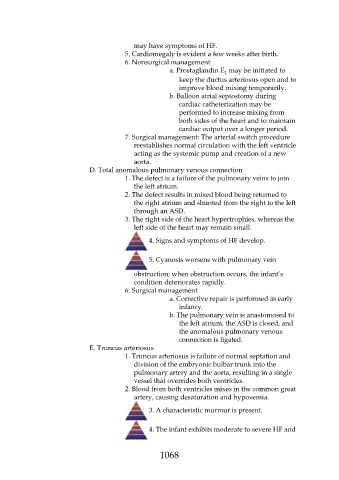Page 1068 - Saunders Comprehensive Review For NCLEX-RN
P. 1068
may have symptoms of HF.
5. Cardiomegaly is evident a few weeks after birth.
6. Nonsurgical management
a. Prostaglandin E may be initiated to
1
keep the ductus arteriosus open and to
improve blood mixing temporarily.
b. Balloon atrial septostomy during
cardiac catheterization may be
performed to increase mixing from
both sides of the heart and to maintain
cardiac output over a longer period.
7. Surgical management: The arterial switch procedure
reestablishes normal circulation with the left ventricle
acting as the systemic pump and creation of a new
aorta.
D. Total anomalous pulmonary venous connection
1. The defect is a failure of the pulmonary veins to join
the left atrium.
2. The defect results in mixed blood being returned to
the right atrium and shunted from the right to the left
through an ASD.
3. The right side of the heart hypertrophies, whereas the
left side of the heart may remain small.
4. Signs and symptoms of HF develop.
5. Cyanosis worsens with pulmonary vein
obstruction; when obstruction occurs, the infant’s
condition deteriorates rapidly.
6. Surgical management
a. Corrective repair is performed in early
infancy.
b. The pulmonary vein is anastomosed to
the left atrium, the ASD is closed, and
the anomalous pulmonary venous
connection is ligated.
E. Truncus arteriosus
1. Truncus arteriosus is failure of normal septation and
division of the embryonic bulbar trunk into the
pulmonary artery and the aorta, resulting in a single
vessel that overrides both ventricles.
2. Blood from both ventricles mixes in the common great
artery, causing desaturation and hypoxemia.
3. A characteristic murmur is present.
4. The infant exhibits moderate to severe HF and
1068

